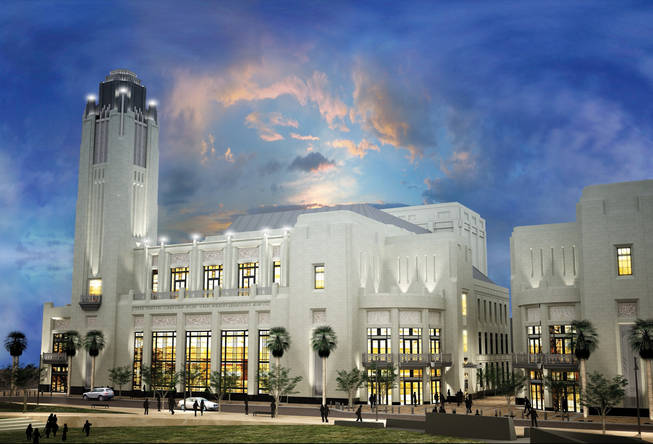
A rendering of The Smith Center for the Performing Arts, scheduled to open its doors in Spring 2012.
Thursday, March 10, 2011 | 7:04 p.m.
It was a big night at the Fifth Street School. Extra chairs. Standing room only.
That was to be expected with this week’s Symphony Park Lecture Series, which featured an engaging panel discussion by The Smith Center design team— architect David M. Schwarz, theater consultant Joshua Dachs and acoustician Paul Scarbrough. Hearing about the merging of acoustics and design was fascinating. The building will be stunning and The Smith Center for the Performing Arts will undoubtedly have a positive impact on our community.
Things, however, got a little unusual when Smith Center CEO Myron Martin introduced Schwarz, and told of the day he brought him to Downtown's 61 acres so he explore the context of the area. Seeing a vast, empty, undeveloped lot, Schwarz, a D.C.-based architect, said he then went to seek perspective on Las Vegas architecture and design and learned that there was “nothing someone hasn’t done"—Venice, ancient Rome, New York.
“The only thing you don’t have in Las Vegas is Las Vegas,” Schwarz said. “When it comes to understanding ‘what is Las Vegas’ and ‘what is iconic Las Vegas,’ it’s hard.’”
The comment was enough to unnerve many dyed-in-the-wool, born-and-raised Las Vegans, fond of the mid-mod architecture, familiar landmarks —both standing and imploded—and cherished neighborhoods emitting rich Las Vegas history.
It's surprising that he would overlook the city by going to the Strip when the whole idea of the Smith Center is to create a community living room that would culturally launch us forward. How can it be that the architect responsible for building this place is studying us by looking at architecture designed for tourists?
Maybe it’s our fault. After all, Schwarz isn't alone in his assessment of the Las Vegas community. The Strip architecture is what we deliver to the world and use to market the city. Our sprawl and our stucco, pop-up homes, facing inward behind stucco walls, equate ugliness and thwart any real sense of community. We could almost argue that, to truly reflect Las Vegas, the Smith Center should be a large boxy Spanish style stucco house—a bold artistic statement.
Problem is, some locals, particularly Downtowners, don't see a boxy stucco home as our identity and will quickly point out that Las Vegas was a very distinctive city before it was trampled by growth, had a sprawling meltdown and became schizophrenic in its design. Today, the valley is dotted with visible remnants of history, particularly downtown. Somehow, Schwarz must have missed all that and the mid-mod movement that took place here and still brings architectural critic Alan Hess to town for lectures. He might not have seen Downtown when he was downtown, probably didn’t know about the railroad history or considered the idea of Las Vegas. But then, many locals don’t either.
Schwarz eventually turned to the Hoover Dam for inspiration because its art deco design is so stunning and because without the Hoover Dam, Las Vegas wouldn’t be what it is today. He’s right about that, but what about the rest of the area's architectural design and history?
Toward the panel’s end, Schwarz told the audience that the Smith Center is designed “to bring you together as a community.” Even if he didn’t see us, he understood that we might need that.

Join the Discussion:
Check this out for a full explanation of our conversion to the LiveFyre commenting system and instructions on how to sign up for an account.
Full comments policy